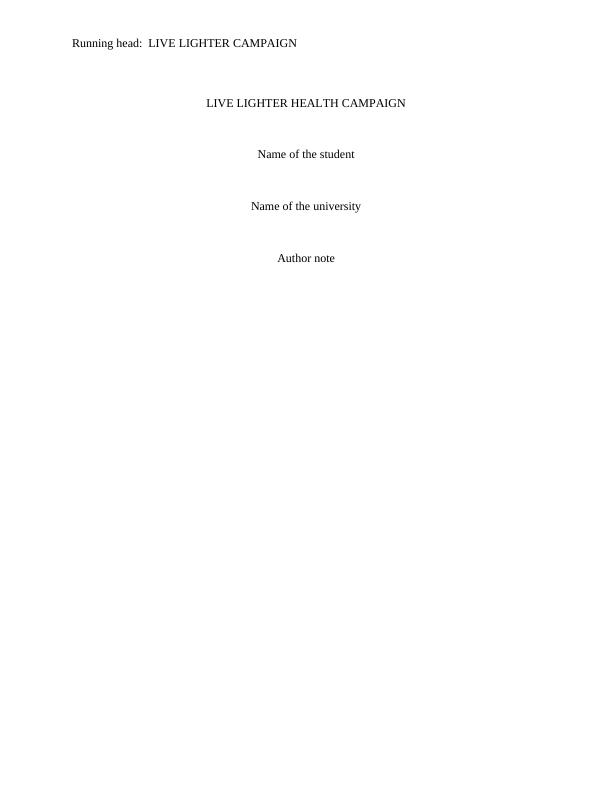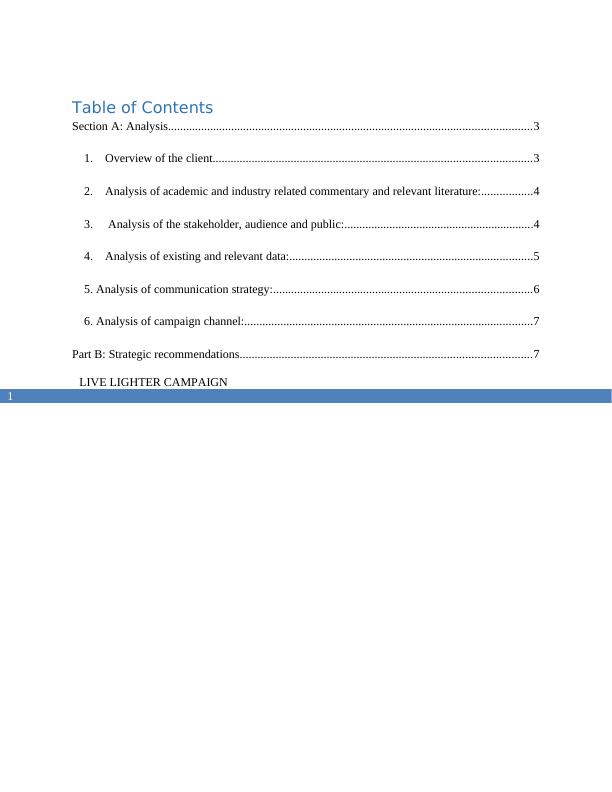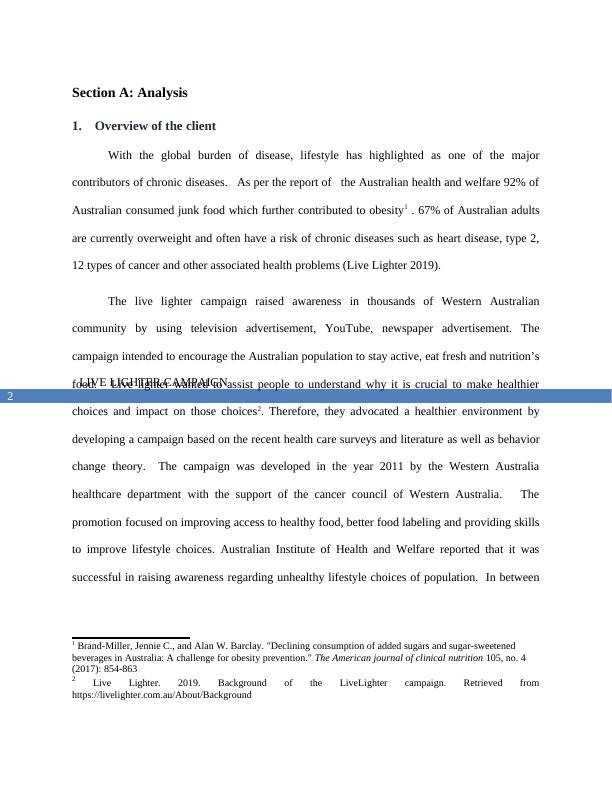Live Lighter Health Campaign
Added on 2022-12-23
12 Pages3131 Words62 Views
Running head: LIVE LIGHTER CAMPAIGN
LIVE LIGHTER HEALTH CAMPAIGN
Name of the student
Name of the university
Author note
LIVE LIGHTER HEALTH CAMPAIGN
Name of the student
Name of the university
Author note

LIVE LIGHTER CAMPAIGN
1
Table of Contents
Section A: Analysis.........................................................................................................................3
1. Overview of the client..........................................................................................................3
2. Analysis of academic and industry related commentary and relevant literature:.................4
3. Analysis of the stakeholder, audience and public:...............................................................4
4. Analysis of existing and relevant data:.................................................................................5
5. Analysis of communication strategy:......................................................................................6
6. Analysis of campaign channel:................................................................................................7
Part B: Strategic recommendations.................................................................................................7
1
Table of Contents
Section A: Analysis.........................................................................................................................3
1. Overview of the client..........................................................................................................3
2. Analysis of academic and industry related commentary and relevant literature:.................4
3. Analysis of the stakeholder, audience and public:...............................................................4
4. Analysis of existing and relevant data:.................................................................................5
5. Analysis of communication strategy:......................................................................................6
6. Analysis of campaign channel:................................................................................................7
Part B: Strategic recommendations.................................................................................................7

LIVE LIGHTER CAMPAIGN
2
Section A: Analysis
1. Overview of the client
With the global burden of disease, lifestyle has highlighted as one of the major
contributors of chronic diseases. As per the report of the Australian health and welfare 92% of
Australian consumed junk food which further contributed to obesity1 . 67% of Australian adults
are currently overweight and often have a risk of chronic diseases such as heart disease, type 2,
12 types of cancer and other associated health problems (Live Lighter 2019).
The live lighter campaign raised awareness in thousands of Western Australian
community by using television advertisement, YouTube, newspaper advertisement. The
campaign intended to encourage the Australian population to stay active, eat fresh and nutrition’s
food. Live lighter wanted to assist people to understand why it is crucial to make healthier
choices and impact on those choices2. Therefore, they advocated a healthier environment by
developing a campaign based on the recent health care surveys and literature as well as behavior
change theory. The campaign was developed in the year 2011 by the Western Australia
healthcare department with the support of the cancer council of Western Australia. The
promotion focused on improving access to healthy food, better food labeling and providing skills
to improve lifestyle choices. Australian Institute of Health and Welfare reported that it was
successful in raising awareness regarding unhealthy lifestyle choices of population. In between
1 Brand-Miller, Jennie C., and Alan W. Barclay. "Declining consumption of added sugars and sugar-sweetened
beverages in Australia: A challenge for obesity prevention." The American journal of clinical nutrition 105, no. 4
(2017): 854-863
2 Live Lighter. 2019. Background of the LiveLighter campaign. Retrieved from
https://livelighter.com.au/About/Background
2
Section A: Analysis
1. Overview of the client
With the global burden of disease, lifestyle has highlighted as one of the major
contributors of chronic diseases. As per the report of the Australian health and welfare 92% of
Australian consumed junk food which further contributed to obesity1 . 67% of Australian adults
are currently overweight and often have a risk of chronic diseases such as heart disease, type 2,
12 types of cancer and other associated health problems (Live Lighter 2019).
The live lighter campaign raised awareness in thousands of Western Australian
community by using television advertisement, YouTube, newspaper advertisement. The
campaign intended to encourage the Australian population to stay active, eat fresh and nutrition’s
food. Live lighter wanted to assist people to understand why it is crucial to make healthier
choices and impact on those choices2. Therefore, they advocated a healthier environment by
developing a campaign based on the recent health care surveys and literature as well as behavior
change theory. The campaign was developed in the year 2011 by the Western Australia
healthcare department with the support of the cancer council of Western Australia. The
promotion focused on improving access to healthy food, better food labeling and providing skills
to improve lifestyle choices. Australian Institute of Health and Welfare reported that it was
successful in raising awareness regarding unhealthy lifestyle choices of population. In between
1 Brand-Miller, Jennie C., and Alan W. Barclay. "Declining consumption of added sugars and sugar-sweetened
beverages in Australia: A challenge for obesity prevention." The American journal of clinical nutrition 105, no. 4
(2017): 854-863
2 Live Lighter. 2019. Background of the LiveLighter campaign. Retrieved from
https://livelighter.com.au/About/Background

LIVE LIGHTER CAMPAIGN
3
2012 to 2016 over 7000 people had participated in the campaign because of the advertisement
(Live Lighter 2019).
2. Analysis of academic and industry related commentary and relevant literature:
With the rapid increase of chronic illness, obesity is one of the major public health
concern in the current era. More than 67% of the individuals in the Australian community are
overweight and 19% of the individuals are suffering from severe health complication because of
obesity3. 340 million children are obese and experiencing health issues4. The prevalence in
Western Australia is higher compared to another region of the community where more than 40%
of individuals were considered as obese in 20145.
Since population nowadays is leading a busy life because of a busy schedule, they are
not aware of their health conditions. Therefore, in order to raise awareness regarding lifestyle
choices, nutritional consumptions and associated health issues, designing health promotional
strategy is an effective strategy where individuals have an opportunity to focus on their health.
Live lighter worked with the universities, communities, and retailer to make this change
happened. Graphics and confronting images helped individuals to raise their concern. This
changed individual health behaviors and community-wide social change6.Moreover, the
3 Sullivan, Elizabeth A., Jan E. Dickinson, Geraldine A. Vaughan, Michael J. Peek, David Ellwood, Caroline SE
Homer, Marian Knight et al. "Maternal super-obesity and perinatal outcomes in Australia: a national population-
based cohort study." BMC pregnancy and childbirth 15, no. 1 (2015): 322.
4 Buchmueller, Thomas C., and Meliyanni Johar. "Obesity and health expenditures: evidence from
Australia." Economics & Human Biology 17 (2015): 42-58.
5 Sullivan, Elizabeth A., Jan E. Dickinson, Geraldine A. Vaughan, Michael J. Peek, David Ellwood, Caroline SE
Homer, Marian Knight et al. "Maternal super-obesity and perinatal outcomes in Australia: a national population-
based cohort study." BMC pregnancy and childbirth 15, no. 1 (2015): 322.
6 Arora, Amit, Deon Nguyen, Quang Vinh Do, Bao Nguyen, Glen Hilton, Loc Giang Do, and Sameer Bhole. "‘What
do these words mean?’: A qualitative approach to explore oral health literacy in Vietnamese immigrant mothers in
Australia." Health Education Journal 73, no. 3 (2014): 303-312.
3
2012 to 2016 over 7000 people had participated in the campaign because of the advertisement
(Live Lighter 2019).
2. Analysis of academic and industry related commentary and relevant literature:
With the rapid increase of chronic illness, obesity is one of the major public health
concern in the current era. More than 67% of the individuals in the Australian community are
overweight and 19% of the individuals are suffering from severe health complication because of
obesity3. 340 million children are obese and experiencing health issues4. The prevalence in
Western Australia is higher compared to another region of the community where more than 40%
of individuals were considered as obese in 20145.
Since population nowadays is leading a busy life because of a busy schedule, they are
not aware of their health conditions. Therefore, in order to raise awareness regarding lifestyle
choices, nutritional consumptions and associated health issues, designing health promotional
strategy is an effective strategy where individuals have an opportunity to focus on their health.
Live lighter worked with the universities, communities, and retailer to make this change
happened. Graphics and confronting images helped individuals to raise their concern. This
changed individual health behaviors and community-wide social change6.Moreover, the
3 Sullivan, Elizabeth A., Jan E. Dickinson, Geraldine A. Vaughan, Michael J. Peek, David Ellwood, Caroline SE
Homer, Marian Knight et al. "Maternal super-obesity and perinatal outcomes in Australia: a national population-
based cohort study." BMC pregnancy and childbirth 15, no. 1 (2015): 322.
4 Buchmueller, Thomas C., and Meliyanni Johar. "Obesity and health expenditures: evidence from
Australia." Economics & Human Biology 17 (2015): 42-58.
5 Sullivan, Elizabeth A., Jan E. Dickinson, Geraldine A. Vaughan, Michael J. Peek, David Ellwood, Caroline SE
Homer, Marian Knight et al. "Maternal super-obesity and perinatal outcomes in Australia: a national population-
based cohort study." BMC pregnancy and childbirth 15, no. 1 (2015): 322.
6 Arora, Amit, Deon Nguyen, Quang Vinh Do, Bao Nguyen, Glen Hilton, Loc Giang Do, and Sameer Bhole. "‘What
do these words mean?’: A qualitative approach to explore oral health literacy in Vietnamese immigrant mothers in
Australia." Health Education Journal 73, no. 3 (2014): 303-312.

End of preview
Want to access all the pages? Upload your documents or become a member.
Related Documents
Live Lighter Health Campaign Analysislg...
|13
|2209
|119
Curbing the Rise in Overweight and Obesitylg...
|12
|3072
|290
Obesity and its impact on health: A primary health care perspectivelg...
|1
|814
|341
Public Policy in Australia: Addressing the Epidemic of Obesitylg...
|8
|1525
|406
Menu Kilojoule Labeling on Fast Foodlg...
|8
|1751
|420
Curbing rise in obesity and overweight in Western Australia in indigenous children living in regional areaslg...
|10
|2002
|2
